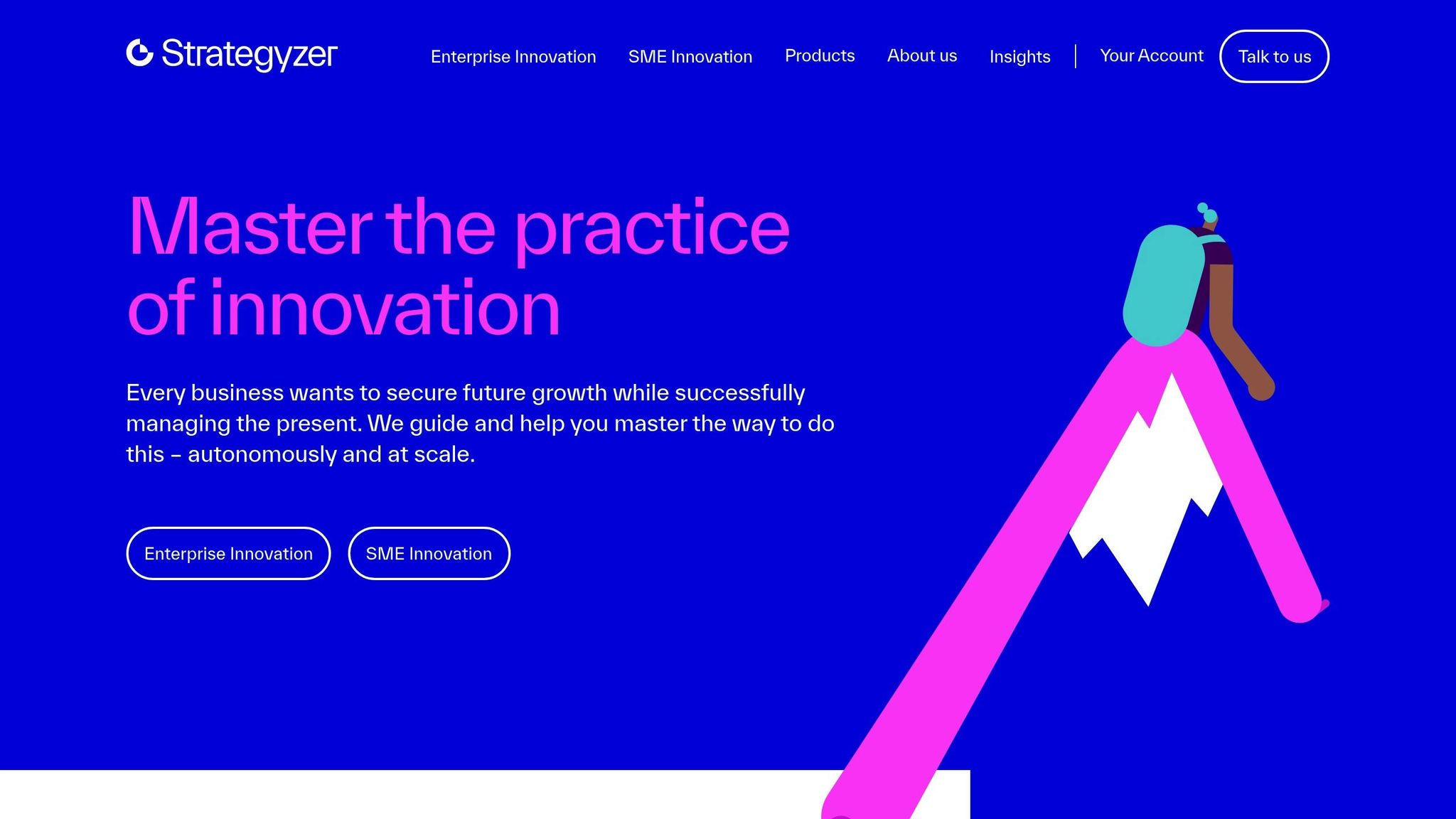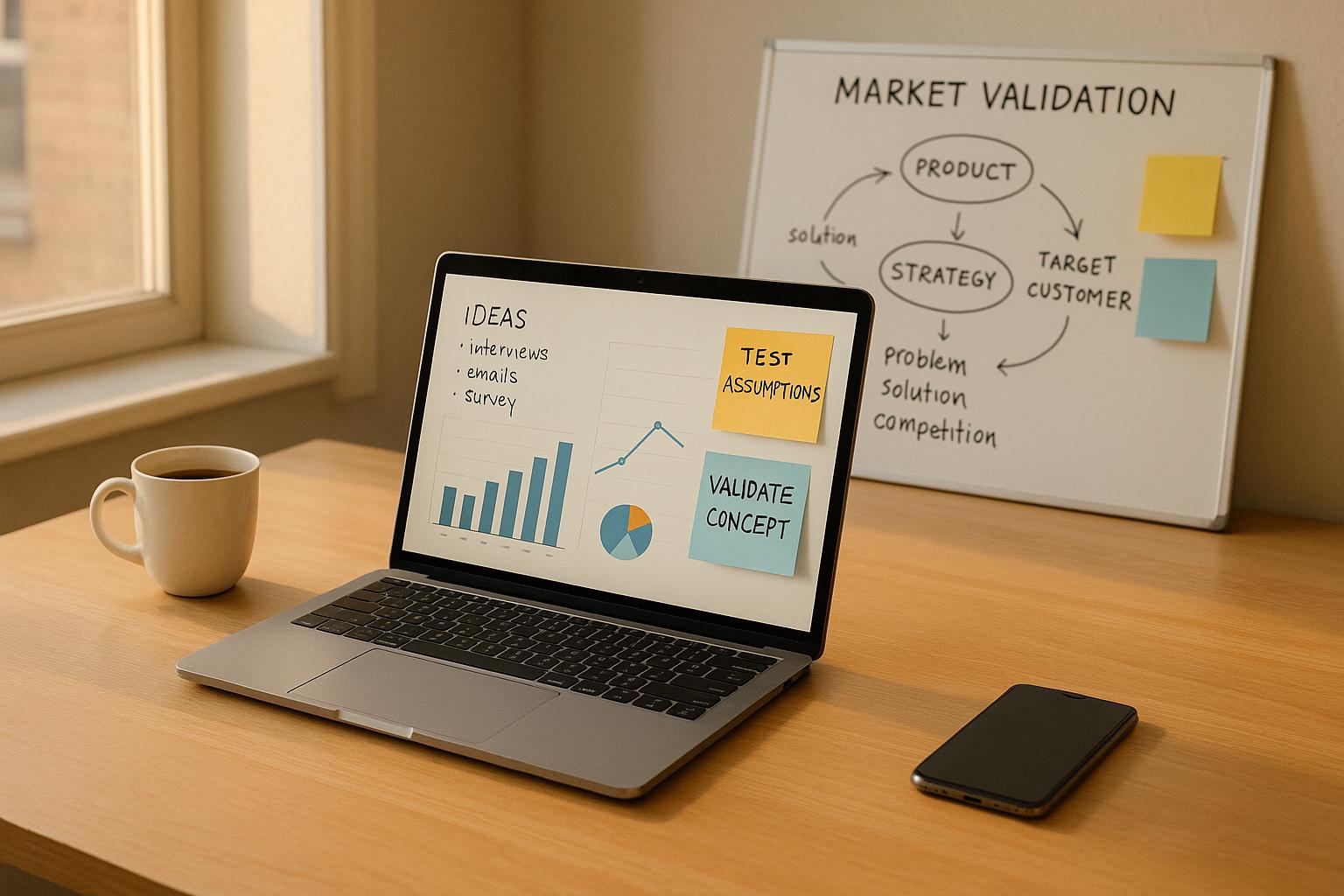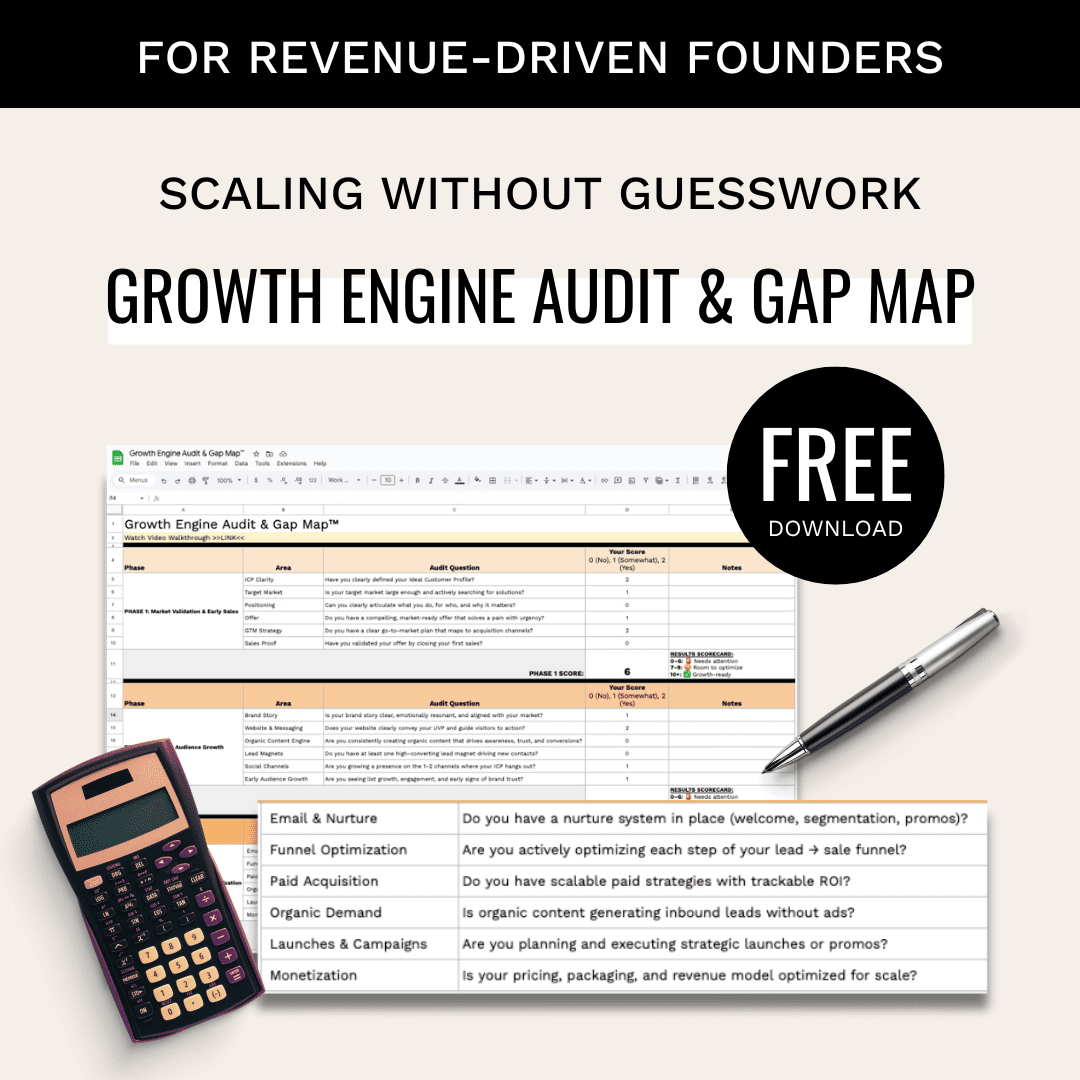Want to avoid costly product failures? Start with market validation. This guide breaks down how to test your product ideas step-by-step using real customer insights before investing heavily in development. Here’s what you’ll learn:
- Common Mistakes: Skipping validation leads to wasted resources, poor product-market fit, and high churn rates.
- Lean Testing: Use quick, data-driven Build-Measure-Learn cycles to minimize risks and focus on what customers actually want.
- Validation Steps:
- Test if your problem is worth solving through customer interviews and data analysis.
- Confirm your solution matches customer needs using prototypes and feedback.
- Build an MVP that focuses only on essential features to test real-world interest.
- Data-Driven Decisions: Use engagement metrics, feedback, and financial data to decide whether to pivot or proceed.
Key takeaway: Validate early, focus on solving real problems, and let customer feedback guide your product development. Ready to dive in?
Strategyzer Webinar: How To Validate Business Ideas

Phase 1: Testing Your Problem Hypothesis
Carefully test your problem hypothesis to confirm the market challenge and steer clear of costly product mistakes.
Listing Key Market Assumptions
Use tools like the Value Proposition Canvas and Business Model Canvas to document your main assumptions. These often fall into three categories:
| Risk Type | Key Questions to Address | Validation Method |
|---|---|---|
| Market Risk | Who needs this? Why do they need it? | Customer interviews |
| Technical Risk | Can we build it? How complex is it? | Technical assessment |
| Financial Risk | Will customers pay? What’s the cost structure? | Market analysis |
"At the center of all testing should always be a deep understanding of the critical hypotheses underlying how you intend to create value for customers (Value Proposition Canvas) and how you hope to create value for your company (Business Model Canvas)" [2].
Running Customer Problem Interviews
Plan your customer interviews with precision. Julia Austin, a product development expert, emphasizes: "Always have a plan. Go in knowing exactly what you’re going to ask and what you want to try to learn in the limited amount of time that you have" [3].
Here are some tips for structuring effective interviews:
- Pre-Interview Setup: Prepare an interview guide and aim for sessions lasting about 30 minutes. Use a two-person team – one to lead the discussion and the other to take notes.
- During the Interview: Focus on actual customer behaviors, not hypothetical situations. Wendy Tsu, Partner of New Business Ventures at AlleyCorp, explains: "At the end of the day if you can deliver a value prop that is better, cheaper, and/or faster – and ideally is operating on at least two of those spheres – customers will pay" [3].
- Post-Interview Analysis: Debrief immediately after each session to capture fresh insights and identify recurring patterns in customer pain points.
These steps can help you uncover valuable insights into customer needs.
Mapping Market Opportunities
Analyzing interview data is key to spotting unmet needs and potential product opportunities. For example, Pioneer Square Labs tested their ChefJoy concept by targeting affluent individuals interested in booking private chefs. After running tests with over 100,000 Instagram users, they found limited interest in their original idea. Instead, they identified a strong demand from new parents looking for convenient at-home dining solutions [4].
"In Product Market Pull (PMP) the primary goal is to learn, not sell." – petermdenton, Product Market Pull [4]
This structured approach to problem validation ensures that resources are directed toward solving real market challenges and encourages teams to pivot when needed based on customer feedback.
Phase 2: Testing Your Solution Ideas
Once you’ve confirmed the problem, the next step is to test your solutions before investing too much time or money.
Writing Your Value Proposition
| Testing Component | Purpose | Key Questions |
|---|---|---|
| Initial Reaction | Understand instinctive response | Does it spark interest or cause confusion? |
| Problem Fit | Check problem-solution match | Does it address their specific pain point? |
| Value Assessment | Measure perceived benefits | What would they trade off for this solution? |
| Price Sensitivity | Test willingness to pay | What price point do they expect? |
"Value propositions are powerful frameworks that enable you to deliver maximum value in minimum time" – Clement Kao, Co-Founder of Product Manager HQ [5]
Getting Solution Feedback
- Customer Interviews
Ask participants to read your value proposition aloud. Pay attention to areas of confusion and note their genuine reactions. - Prototype Testing
Use basic mockups to present your core value propositions. Observe how much genuine interest they show.
"Customers don’t search for ideas; they search for solutions to their highest-priority problems" – Shreyas Doshi, Former Product Leader at Stripe [6]
Planning Market Entry
- Channel Strategy
Identify the best channels to reach your target customers. Map their journey and experiment with different messaging approaches. - Initial Market Focus
Start with the market segment that has the most pressing need. Define your success metrics and plan future growth based on demand. - Launch Parameters
Establish metrics to validate your approach, decide when to pivot or persevere, and set up feedback loops to refine your strategy.
Up next, we’ll dive into building and testing MVPs using these validated solutions.
sbb-itb-e8c8399
Phase 3: Building and Testing MVPs
Once you’ve validated your problem and solution, it’s time to create and test your Minimum Viable Product (MVP). This step helps confirm your key assumptions with real users before committing to full-scale development.
Defining Your MVP Scope
The success of your MVP hinges on focusing exclusively on the essentials. As Warren Smith explains, "A thorough MVP technical requirements review is a critical step in the product development lifecycle. It allows stakeholders to assess the feasibility and viability of the proposed MVP and make informed decisions before investing significant resources into development" [7].
| MVP Component | Key Considerations | Success Criteria |
|---|---|---|
| Core Features | Focus on essential needs | Must solve the primary user problem |
| Technical Requirements | Assess feasibility | Must be achievable with available resources |
| User Experience | Keep it simple but functional | Should support key user interactions |
| Success Metrics | Define measurable KPIs | Outcomes tied to core metrics |
A well-defined MVP scope ensures you’re ready to test your ideas effectively.
Setting Up MVP Tests
Use cost-effective methods to test your MVP and gather actionable feedback. Research indicates that nearly 80% of startups fail due to insufficient testing [9]. Here are a few proven approaches:
- Landing Page Tests
Create a landing page that highlights your primary solution. A great example is Dropbox, which used a simple explainer video on their landing page. This approach skyrocketed their sign-ups from 5,000 to 75,000 overnight [8]. - Manual-First Testing
Before diving into full development, test your concept manually. For instance, Zappos founder Nick Swinmurn manually fulfilled shoe orders from local stores to validate the demand for online shoe sales. This method laid the groundwork for Zappos‘ success, leading to its $1.2 billion acquisition in 2009 [8]. - Beta Testing Program
Launch a beta program with a small, targeted group of users to gather initial feedback [10].
Tracking MVP Results
Monitor metrics that provide clear insights into product-market fit and user value. Focus on these key indicators:
| Metric Category | Key Indicators |
|---|---|
| User Engagement | Daily/Monthly Active Users |
| Retention | 30-day retention rate |
| Customer Satisfaction | CSAT score (aim for 80% or higher) |
| Feature Usage | Adoption rate of core features |
| Conversion | Ratio of sign-ups to active users |
Instagram offers a great example of tracking focused metrics during its MVP phase. They concentrated on just two KPIs: user sign-ups and engagement, which included posts shared and photos liked. This helped validate their core idea of a simple photo-sharing app with filters [11].
Phase 4: Making Data-Driven Decisions
Understanding Test Results
Carefully review both numbers and user feedback to spot patterns in behavior and gauge how well your product fits the market. Key areas to monitor include:
- User Engagement: How often and consistently users interact with your product.
- Customer Feedback: Assess whether your solution effectively addresses their needs or problems.
- Market Interest: Look at how committed potential buyers are.
- Financial Viability: Compare what it costs to acquire customers to the revenue they bring over time.
Use these insights to shape and refine your business approach.
Refining Your Business Model
Adapt your business model based on what the data tells you:
- Validate Customer Problems
Look for recurring feedback that confirms your product is solving real issues for users. - Adjust Your Value Proposition
Highlight features that users engage with most and phase out those that underperform. - Reassess Your Target Market
Focus on the audience segments where your product resonates the most.
Deciding on the Next Steps
Use market signals to decide whether to pivot or stay the course. Here’s a quick guide:
| Signal | Pivot If… | Stay the Course If… |
|---|---|---|
| User Engagement | Low adoption rates persist | Strong retention is evident |
| Customer Feedback | Feedback is mostly negative | Users clearly see value |
| Market Response | Buyers show little interest | Customer base is growing |
| Financial Metrics | Costs outweigh returns | ROI is improving |
Keep these points in mind as you move forward:
- Collect both usage data and user feedback.
- Measure performance against your business goals.
- Set clear, measurable objectives for future iterations.
- Regularly evaluate how your product is doing.
- Stay open to constructive criticism.
Avoid making hasty changes. Instead, base your decisions on reliable data. This phase wraps up the lean validation process, paving the way for thoughtful product development.
Conclusion: Market Validation & Learning Before Building!
Key Takeaways for Product Teams
Testing your market early can save time, money, and effort by confirming whether your idea aligns with actual customer needs. Market validation helps you determine if your concept is worth pursuing. For example, eDreams has seen many product tests fail, underscoring the importance of validation.
| Validation Stage | Key Outcomes | Business Impact |
|---|---|---|
| Problem Testing | Confirms market demand | Lowers risk during development |
| Solution Testing | Ensures customer alignment | Guides product direction |
| MVP Testing | Provides usage insights | Tests the business model |
| Decision Making | Identifies next steps | Improves resource allocation |
These steps provide a roadmap for effective market validation.
Starting Your Validation Process
Kick things off by testing the assumptions that carry the most risk:
- Focus on Learning: Prioritize quick and efficient tests to gather insights.
- Be Ready to Adapt: Use market feedback to refine your approach.
- Adopt a Humble Mindset:
"It all goes back to: be humble and learn more than explain." [12]
Instead of relying on vague interest, aim for real customer commitments. Malte Scholz, CEO of airfocus, emphasizes that validation combines user interviews, data analysis, experiments, and MVP testing [12].
"It is not necessarily the smallest product imaginable…it is simply the fastest way to get through the Build-Measure-Learn feedback loop with the minimum amount of effort." [1]
FAQs
How can I validate the main problem my product solves before starting development?
To validate the core problem your product addresses, start by deeply understanding the issue and confirming its relevance to your target audience. Focus on these key steps:
- Understand the problem: Identify how widespread the issue is, why it exists, and whether current solutions are inadequate.
- Engage with potential users: Talk directly to your target audience to learn about their needs, challenges, and motivations.
- Ask open-ended questions: Explore what users are trying to achieve, how they currently address the problem, and where they face frustrations.
Avoid making assumptions – let real user feedback guide you. This ensures you’re solving a meaningful problem and sets the foundation for a successful product.
What are the best ways to conduct customer interviews to gather meaningful insights for market validation?
To gather meaningful insights during customer interviews, start by clearly defining your goals and identifying the right audience to speak with. Prepare open-ended questions that encourage customers to share their real-world experiences, focusing on their challenges and needs rather than hypothetical scenarios. Avoid leading questions and let the conversation flow naturally.
During the interview, practice active listening – let the customer do most of the talking while you take detailed notes or record the session (with their permission). Pay attention to recurring themes or pain points, and use techniques like the "5 Whys" to uncover the deeper causes behind their challenges. Afterward, review and analyze the feedback with your team to identify patterns and refine your approach.
Remember to focus on understanding the customer’s problems before discussing your solution. This helps you avoid bias and ensures you’re building something that truly addresses their needs. Use the insights gained to iterate and improve your product or service.
How can I identify the key features for my MVP to test market demand without overspending on development?
To pinpoint the key features for your Minimum Viable Product (MVP) without over-investing, focus on solving your users’ primary pain points with the smallest, most impactful feature set. Start by defining your core value proposition – the unique benefit your product offers. Then, conduct user research through surveys or interviews to understand what matters most to your audience.
Prioritize features that deliver maximum value while aligning with your business goals. Techniques like the MoSCoW method (Must-haves, Should-haves, Could-haves, Won’t-haves) can help you decide what’s essential. Release your MVP with just enough functionality to address the core problem and gather feedback from real users. Use their input to refine and improve your product over time.
Related Blog Posts
- Ultimate Guide to Self-Serve Product-Led Growth
- How to Build a Lead Qualification Framework
- Adapting SaaS Value Propositions for Global Users
- Ultimate Guide to B2B Buyer Interviews




